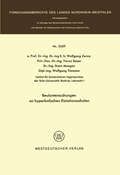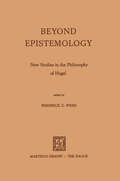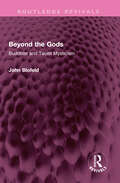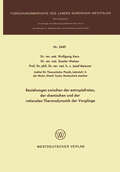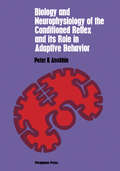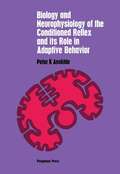- Table View
- List View
Betriebswirtschaftslehre: Systeme, Entscheidungen, Methoden; ein Arbeitsbuch in Frage u. Antwort zu Betriebswirtschaftliche Logistik, 1973, W. Kirsch, Entscheidungsprozesse, Bd. 1 - 3
by Werner KirschBetriebswirtschaftslehre: Ein Lehr- und Nachschlagewerk für Unterricht und Selbststudium
by Alfred Heinz BahnBetriebswirtschaftstheorie: Band 1: Grundlagen, Produktions- und Kostentheorie (Heidelberger Taschenbücher #156)
by W. Busse von Colbe G. LassmannBeuluntersuchungen an hyperbolischen Rotationsschalen (Forschungsberichte des Landes Nordrhein-Westfalen #2439)
by Wolfgang ZernaBevölkerungsentwicklung und Erwerbstätigkeit: Ein Beitrag zur Simulation sozioökonomischer Systeme mit Prognosen für die Bundesrepublik Deutschland
by Peter HecheltjenBeyond Epistemology: New Studies in the Philosophy of Hegel
by F.G. WeissThis book approaches Hegel from the standpoint of what we might call the question of knowledge. Hegel, of course, had no "theory of knowledge" in the narrow and abstract sense in which it has come to be understood since Locke and Kant. "The examination of knowledge," he holds, "can only be carried out by an act of knowledge," and "to seek to know before we know is as absurd as the wise resolution of Scholasticus, not to venture into the water until he had learned to swim. " * While Hegel wrote no treatise exclusively devoted to epistemology, his entire philosophy is nonetheless a many-faceted theory of truth, and thus our title - Beyond Epistemology - is meant to suggest a return to the classical meaning and relation of the terms episteme and logos. I had originally planned to include a lengthy introduction for these essays, setting out Hegel's general view of philosophic truth. But as the papers came in, it became clear that I had chosen my contributors too well; indeed, they have all but put me out of business. In any case, it gives me great pleasure to have been able to gather this symposium of outstanding Hegel scholars, to provide for them a forum on a common theme of great importance, and especially, thanks to Arnold Miller, to have Hegel himself among them. Frederick G. Weiss Charlottesville, Va. • The Logic of Hegel, trans. from the Etu;yclopaedta by William Wallace. 2nd ed.
Beyond the Gods: Buddhist and Taoist Mysticism (Routledge Revivals)
by John BlofeldFirst published in 1974 Beyond the Gods argues that true mystics transcend religious boundaries, and that Eastern mysticism has increasing relevance for the troubled minds and spirits of the West. Blofeld’s approach is a highly personal one based on encounters with monks, lamas, and recluses in their mountain retreats. He also includes a vivid description of the Chinese religious scene and chapters on the mystical practices of Taoism, Ch’an (Zen) and the Tantric Buddhism of Tibet. The book seeks to answer broader questions like – what has Eastern mysticism to offer the West, how can we free ourselves from the pressures of modern life or benefit from eastern methods of cultivating the sublime mystical experience? This is an interesting read for scholars and researchers of Buddhism, Taoism, and religion in general.
Beyond the Gods: Buddhist and Taoist Mysticism (Routledge Revivals)
by John BlofeldFirst published in 1974 Beyond the Gods argues that true mystics transcend religious boundaries, and that Eastern mysticism has increasing relevance for the troubled minds and spirits of the West. Blofeld’s approach is a highly personal one based on encounters with monks, lamas, and recluses in their mountain retreats. He also includes a vivid description of the Chinese religious scene and chapters on the mystical practices of Taoism, Ch’an (Zen) and the Tantric Buddhism of Tibet. The book seeks to answer broader questions like – what has Eastern mysticism to offer the West, how can we free ourselves from the pressures of modern life or benefit from eastern methods of cultivating the sublime mystical experience? This is an interesting read for scholars and researchers of Buddhism, Taoism, and religion in general.
Beyond the Village: Local Politics in Madang, Papua New Guinea
by Louise MorautaA study of how a district of Papua New Guinea dealt with the new political institutions established in the last years of colonial rule. The Monographs on Social Anthropology were established in 1940 and aim to publish results of modern anthropological research of primary interest to specialists.
Beyond the Village: Local Politics in Madang, Papua New Guinea (London School Of Economics Monographs On Social Anthropology Ser. #No. 49)
by Louise MorautaA study of how a district of Papua New Guinea dealt with the new political institutions established in the last years of colonial rule. The Monographs on Social Anthropology were established in 1940 and aim to publish results of modern anthropological research of primary interest to specialists.
Beziehungen zwischen der entropiefreien, der chemischen und der rationalen Thermodynamik der Vorgänge (Forschungsberichte des Landes Nordrhein-Westfalen)
by Wolfgang KernBibliography 1972–73 Organic and Organometallic Crystal Structures (Molecular Structure and Dimensions #5)
by O. Kennard D. G. Watson W. G. TownThis volume is the fifth c1assified bibliography of organic and organometallic crystal structures prepared by the Crystallographic Data Centre, University Chemical Laboratory, Cambridge, and püblished jointly with the International Union of Crystallography. The first four volumes covered the years 1935-1972. The present volume provides references principally to compounds whose struc tures were reported in the literature during 1972-1973. A few structures published prior to 1972 and omitted from the previous volumes are also included. The arrangement of entries in the 86 chemical c1asses is identical with the previous volumes and the reader is referred to the r ntroduction in Vol. I or Vol. 2 for a description of the practical use of the bibliography. There are three cumulative indexes in the present volume: formula, transition metal and author indexes. All three cover the period 1935- 1973 and give references to entries in Vois. 1-5. The bibliography and indexes were prepared, checked and printed by computer techniques described in the previous volumes. Magnetic tapes of the five volumes are available and anyone interested should contact the Centre for further details. Cn the present volume we have continued the special arrangement for literature search with the Centre National de la Recherche Scientifique, Paris, France. U nder this arrangement reprints of papers containing crystallographic data are sent directly to the Crystal lographic Data Centre, Cambridge, at the same time as they are sent out to abstractors preparing material for the Bulletin Signaletique.
Biene und Honig als Symbol des Dichters und der Dichtung in der griechisch-römischen Antike: 186. Sitzung am 20. Juni 1973 in Düsseldorf (Rheinisch-Westfälische Akademie der Wissenschaften #196)
by Jan Hendrik WaszinkBiochemistry of Sensory Functions: 25. Colloquium am 25.-27. April 1974 (Colloquium der Gesellschaft für Biologische Chemie in Mosbach Baden #25)
by L. JaenickeThis volume contains the Proceedings of the 25th Mosbach Colloquium, the general theme of which is the Biochemistry of Sensory Functions. It was intended, continuing the silver-tradition of these Colloquia, to provide the uninitiated biochemist with an insight into the current status of a line of research in Molecular Biology which, more than many other fields in Biochemistry, has maintained its contacts with and respect for Physiology. The speakers were asked to attempt to outline their topic sufficiently to define the fundamentals and to build up upon this basis the more sophisticated details of their own studies. It is for the reader to evaluate how well both organizer and participants 1 have attained this end • These Proceedings not only mirror the hubs around which several groups of scientists wheel but may also serve as a source of literature references and for the advanced student as an introduction to this highly up-to-date branch of Biochemistry, although no index is provided as the table of con tents is considered sufficient to locate most of the s,
Biochemistry of Women: Clinical Concepts
by A.S CurryThis book concerns the clinical chemistry of women � from conception to the grave. It concerns their medical problems and the laboratories� role in elucidating these and in monitoring treatment. The book represents the current �state of the art� and although in many areas there are sometimes widely divergent opinions, it is good that these should be aired so that problem areas can be revealed and opinions revised when further experimental work is done as a consequence.
Biochemistry of Women: Clinical Concepts
by A.S CurryThis book concerns the clinical chemistry of women � from conception to the grave. It concerns their medical problems and the laboratories� role in elucidating these and in monitoring treatment. The book represents the current �state of the art� and although in many areas there are sometimes widely divergent opinions, it is good that these should be aired so that problem areas can be revealed and opinions revised when further experimental work is done as a consequence.
Biochemistry of Women Methods: For Clinical Investigation
by A.S. CurryThis book is written by experts who, using the latest techniques, describe laboratory investigations into women from conception to the grave. We asked the authors tp pay particular attention to the interpretation of laboratory results so we hope the book will be of interest to clinicians as well as to medical scientists.
Biochemistry of Women Methods: For Clinical Investigation
by A.S. CurryThis book is written by experts who, using the latest techniques, describe laboratory investigations into women from conception to the grave. We asked the authors tp pay particular attention to the interpretation of laboratory results so we hope the book will be of interest to clinicians as well as to medical scientists.
Biogeography and Ecology in Tasmania (Monographiae Biologicae #25)
by W. D. WilliamsDistribution and Range . . . 142 The Tasmanian Trout Fishery 153 Population Dynamics of Tench 163 Conservation Notes 167 Bibliography . . . . . . . . 168 VII. Littoral Biogeography by A. J. DARTNALL 171 Introduction . . . . . . . . . . . . . . 171 The Maugean Marine Province. . . . . . 175 Distribution Patterns of some Tasmanian Marine Animals 178 Conclusions. . . . 190 Acknowledgements 191 Bibliography . . . 191 VIII. The Zoogeography and Evolution of Tasmanian Oligochaeta by B. G. M. JAMIESON. . 195 Introduction . . . . . . . . . . . . 195 The Australian Region: A World Perspective 198 Earthworms and Continental Drift. . . . . 206 Tasmanian Earthworms - Relationships with the Australian Fauna. . . . . . . . . . . . . . . . . . . . . . . 210 Tasmanian Megasco1ecid Species and Aspects of their Evolution . 218 Bibliography . . . . . . . . . . . 226 IX. Oniscoidea (Terrestrial Isopoda) by ALISON J. A. GREEN . . . . . . . 229 Introduction . . . . . . . . . . . 229 Ecological Distribution. . . . . . . 229 Comments on Ecological Distribution 235 Geographical Distribution of Species Recorded from T- mania. . . . . . . . . . . . . . . . . . . . . . . 237 Geographical Distribution of Genera Recorded from T- mama. . . . . . 239 Acknowledgements 247 Bibliography . . . 247 X. The Amphibia of Tasmania by M. J. LITTLEJOHN and A. A. MARTIN 251 Introduction 251 Taxonomy. 251 Distribution 265 Biology . . 268 Zoogeography . . 272 Evolution . . . . 277 Acknowledgements 282 Bibliography . . . 282 Key 1: Key to Frogs (Adults) . 286 Key 2: Key to Male Mating Calls . 287 Key 3: Key to Eggs. . 288 Key 4: Key to Tadpoles . . . . . 289 XI. Biogeography and Ecology of the Reptiles of Tasmania and the Bass Strait Area by P. A. RAWLINSON. 291 Introduction . . . . . . . . . . . . . . . 291 Cainozoic Climates and Pleistocene Sea Levels. 292 Present Climate. . . . . . . . . . . . . . 297 Ecological Requirements of Reptiles. . . . . 299 The Reptile Fauna of Tasmania and the Bass Strait Area - Composition, Ecology and Distribution. . . .
Biological Mechanisms of Attachment: The Comparative Morphology and Bioengineering of Organs for Linkage, Suction, and Adhesion
by W. NachtigallBioengineering is the branch of biology which applies the methods of engineering and physics to the study of biological phenomena, and the vocabulary of technology to describe them. Particularly with respect to the mechanics of movement and other physiological processes, the advantages of this approach are obvious. But other fields of study also reveal new insights when biotechnical research methods are applied, and one of these is the comparative morphology of biological structures. At the very least, description in technical terms permits complete, concise organization of a field of research, provides a means of describing biological forms in terms consistent with their function, and aids in working out interpretations based on structural design and functional anatomy. It is from this point of view that the present book describes and discusses, on a comparative basis, biological mechanisms of at tachment. Although these are among the simplest biological mechanisms, they are fascinating in their diversity. This presentation is, in a way, an outgrowth of that encyclopedic drive which is within every scientist. Over the years, whole libraries of books have been scanned as a result of this general curiosity; the library of the Munich Zoological Institute has proved a particularly valuable source of information. This little book is a much ab breviated distillation of the several thousand file cards which resulted from this urge to collect.
Biologie für Mediziner: Begleittext zum Gegenstandskatalog (Heidelberger Taschenbücher #154)
by W. BuselmaierDie traditionellen Inhalte des Mediziner-Unterrichtes in Zoologie und Botanik gehen auf eine Zeit zurück, in welcher der Arzt noch selbst seine Heilkräuter mischte und im Städt chen der "Naturkundige" war. Immer wieder hat man an verschiedenen Stellen versucht, einen Unterricht anzubieten, der den modernen Entwicklungen innerhalb der Biologie besser entsprach und gleichzeitig den Bedürfnissen einer na turwissenschaftlich orientierten ärztlichen Arbeit weiter ent gegenkam. Je nach den persönlichen Interessen der zufällig mit dem Mediziner-Unterricht betrauten akademischen Lehrer entwickelte sich so eine Heterogenität des Lehrange botes, die wohl in keinem anderen Fach der ärztlichen Aus bildung ihresgleichen fand. Auf diese Situation traf die neue Approbationsordnung rur Ärzte, und es kann nicht wunder nehmen, daß die Vorschrif ten' welche man in ihr rur den Biologie-Unterricht findet, sehr allgemein formuliert und überaus umfassend gehalten sind; um die dort vorgeschriebenen Lernziele wirklich zu erreichen, dazu reicht ein volles Biologiestudium kaum aus. Andererseits wurde das vorklinische Studium gegenüber frü her von 5 auf 4 Semester reduziert, und es kamen zwei neue Fächer (Medizinische Psychologie und Soziologie) hinzu. Dieser Gesamtstoff ist nur zu bewältigen, wenn man den Stoff in den "alten" Fächern, unter anderem in der Biologie, reduziert. In dieser Lage hatte die Kleine Kommission, die den Gegen standskatalog rur die ärztliche Vorprüfung herzustellen be auftragt war, zwei Möglichkeiten: 1. Sie konnte das Gesamtvolumen des traditionellen Lehr stoffes sozusagen maßstabgerecht reduzieren.
Biology and Neurophysiology of the Conditioned Reflex and Its Role in Adaptive Behavior: International Series of Monographs in Cerebrovisceral and Behavioral Physiology and Conditioned Reflexes, Volume 3
by Peter K. AnokhinBiology and Neurophysiology of the Conditioned Reflex and its Role in Adaptive Behavior explores the conditioned reflex, its historic development, and its functions and roles. The book also aims to bridge the gap between the integrative level of higher nervous activity and fine detailed neurophysiological investigations, giving light to the basis of the term “learning". The book, as an introduction, covers the biological roots of the conditioned reflex and the nature of the unconditioned reflex, then moves on to the different bases, hypotheses, and theories of both the coupling of the conditioned reflex; the physiological architecture of the behavioral act; the mechanism of action and function of conditioned inhibition function; and certain correlations in the study of this phenomenon. The text is recommended for biologists, zoologists, psychologists, and neuroscientists from different backgrounds who wish to know more about how the conditioned reflex, and ultimately learning, came about.
Biology and Neurophysiology of the Conditioned Reflex and Its Role in Adaptive Behavior: International Series of Monographs in Cerebrovisceral and Behavioral Physiology and Conditioned Reflexes, Volume 3
by Peter K. AnokhinInternational Series of Monographs in Cerebrovisceral and Behavioral Physiology and Conditioned Reflexes, Volume 3: Biology and Neurophysiology of the Conditioned Reflex and its Role in Adaptive Behavior focuses on the biological roots, characteristics, and nature of conditioned reflex and its function in adaptive behavior. The monograph first discusses the biological roots of the conditioned reflex. Concerns include sequential order of external influences and living protoplasm; anticipatory processes of protoplasm and the conditioned reflex; adaptive features of the conditioned reflex; and inborn signalization in higher animals. The book then takes a look at the nature of the unconditioned reflex, including biological nature of reinforcement; value of the temporal relationships of conditioned and unconditioned reflexes; and fixation of sequential order without the factor of reinforcement. The text describes systemogenesis as an evolutionary basis for the development of unconditioned reflexes; concepts concerning the nature of the coupling process; and hypothesis of the convergent coupling of the conditioned reflex. The book also examines functional system as a basis of the physiological architecture of behavioral acts. The monograph is a dependable source of data for readers interested in conditioned reflex and its function in adaptive behavior.
The Biology of Alcoholism: Volume 3: Clinical Pathology
by Benjamin Kissin Henri BegleiterIn this volume, the third of our series, the emphasis has shifted from the theoretical and experimental to the more clinical and practical aspects of alcoholism. Where, in the earlier volumes, more attention was directed to animal than human studies, in this volume, almost all material deals with the human condition. The clinical manifestations of alcoholism may be divided into two major aspects, that of the disease itself and that of its complications. This separation is to some extent artificial since, in a sense, the natural history of the disease is a function of the development of certain complicating mechanisms. These mechanisms in turn either become part and parcel of the underlying condition -alcoholism-or give rise to a new set of clinical variables characterized as "medical complications. " At this point, the dichotomy becomes real. The disease alcoholism tends to be seen as a distinct psychosocial entity and to be treated with psychosocial techniques. The "medical complications" are more clearly envisioned as being within the legitimate domain of medical practice and are treated by physicians who often tend to ignore the underlying alcoholism. The "patient" is sometimes lost in between. The major thrust of this volume is an attempt to describe the mechanisms of alcoholism as they are now known, in such a way as to establish a continuum between the disease alcoholism and its "medical complications.



